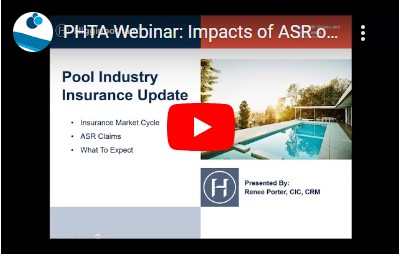advocacy
Alkali-Silica Reaction (ASR)
Alkali-Silica Reaction (ASR) has been a long-standing issue in the concrete industry (think highways, bridges, buildings) dating back to the 1940s. Because pools are subject to water 24/7, special care needs to be taken in laying concrete for pools, including following important codes and standards from the Pool & Hot Tub Alliance (PHTA) and the American Concrete Institute (ACI). ASR damage in concrete pools can be substantial, leaving homeowners with little to no choice but to replace the pool.
The impact on pool builders can be substantial as well due to the delay in signs of ASR appearing, taking more than two years to appear in many cases. If pool builders are unaware of mix changes, many pools can be built without knowledge that the concrete does not meet the requirements for building pools.
Currently, there are several locations in the United States experiencing “outbreaks” of ASR, most notably Austin, TX. However, this situation can happen anywhere there is a breakdown in communication between the concrete providers and the pool builders. The situation in Austin, for example, was due to a shortage in fly ash and concrete providers not informing the pool builders that they were not including it in the mix when it was hard to source.
Class F Fly Ash is not the holy grail for pool builders, but it is a safeguard that helps eliminate or severely reduce the impact of ASR. Adhering to ACI Code 318 is the best start, followed by mandating Class F fly ash in your shotcrete mix. Making sure you have mix tickets is also a safeguard. Lastly, the impact of the central Texas case has resulted in insurance companies requiring pool builders use a master agreement with their concrete sub contractors. An example of a master agreement is linked below.
PHTA is closely monitoring the ASR situation and will continue adding more resources to this page. PHTA has also formed an ASR Task Force made of a wide range of experience in the industry, including builders from several locations across the country, ACI representatives, National Plasterers Council (NPC) representatives, insurance agents, and expert engineers. To contact the Task Force, reach out to Jeff Henriksen, PHTA Vice President of Industry Affairs & Research, at jhenriksen@phta.org.
Articles
- ASR Progression in Central Texas (AQUA Magazine, July 2025)
- Alkali-Silica Reaction (ASR) – An Industry Threat
Resources
- ASR FAQ for Builders
- ASR FAQ for Consumers (available to PHTA members only)
Webinars
ASR Sample Contract
If pool builders want to reduce their risk of ASR happening in their pools, they need to establish a more formal relationship with their concrete subcontractor. This includes having a written and executed subcontractor agreement similar to the example here. Pool builders should also have these types of agreements with any other subcontractors or parties providing materials or performing work on your job site.
The subcontract should clearly specify the work to be done; quality of materials to be used; require subcontractors carry adequate insurance policies; and include an indemnification clause, to name a few of the clauses to include. Another way to reduce the risk of ASR is to make sure you get a copy of the mix ticket at time of delivery. If the subcontractor cannot provide it, turn the order away.
In terms of insurance, many carriers are trying to exclude silica. A solution offered by an insurance broker is to carry a pollution policy which would cover silica in the pool and air.
Note: While PHTA endeavors to provide useful information for its members, it cannot provide legal or insurance advice. Pool Builders and Service Professionals should consult with their own legal counsel and insurance professionals to tailor an approach best suited for their business and circumstances.
A sample contract for general informational purposes is available here.









